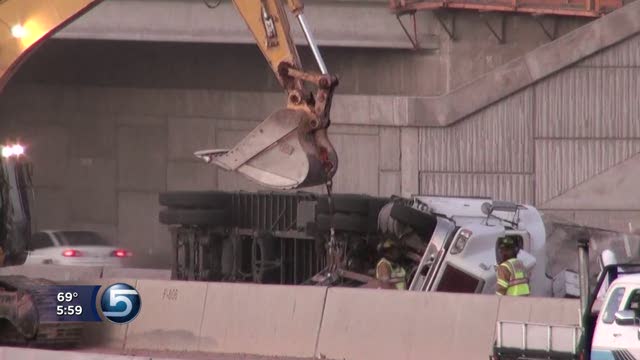Estimated read time: 2-3 minutes
This archived news story is available only for your personal, non-commercial use. Information in the story may be outdated or superseded by additional information. Reading or replaying the story in its archived form does not constitute a republication of the story.
ST. GEORGE — Emergency response crews were faced with an interesting challenge Sunday.
Surprisingly, an overturned semi-truck on I-15 wasn't their biggest problem. They knew how to deal with that. It was the estimated 25 million bees the semi was hauling that created issues.
Police, firefighters, paramedics and others battled being stung by bees as they worked to help the semi driver, who suffered minor injuries. No other vehicles were involved in the crash, which happened in a construction zone near Exit 6.
Marty Ferguson drove up on the scene and saw people running away, waving their shirts. "They had taken their shirts off and they were just hitting themselves on the head and the body trying to keep something away," he said.
As for rounding up the bees, about 20 local beekeepers were called in to assist.
Washington County bee inspector Casey Lofthouse said, "A lot of the beekeepers sustained stings, a few of them; maybe some construction workers, too. But for the most part, I think it was minimal."
He said the key was getting the overturned boxes that housed each colony set back up and placed on pallets that could be transferred to another vehicle.
There were two boxes per colony and four colonies per pallet, Lofthouse said. Each colony contained an average of 80,000 bees. Part of the challenge, he said, was making sure the correct two boxes were matched together. If a box that contained one-half of a colony was placed with a box that contained a different colony, the bees would attack each other, he said.
You can't just grab any two boxes. When you throw those two colonies together they just kill each other.
–Casey Lofthouse
"You can't just grab any two boxes," he said. "When you throw those two colonies together they just kill each other."
Lofthouse, who was stung about two dozen times himself Sunday, said it was easy to round the bees up once it got dark. The bees naturally began to cluster up and went back into their colony box.
"A lot of bees will go back in," he said. "After dark they don't fly, they just crawl around."
An estimated two-thirds of the 25 million bees were recovered. Lofthouse said the remaining bees that were not captured or killed likely would be around the area where the accident occurred for about a week.
"You know, I think the real story comes out with the local beekeepers rallying together and getting down there and doing what they could to mitigate the owner's losses," Lofthouse said.
The person who owns the bees, at a South Dakota honey farm, said he was very grateful for all the work of the local beekeepers and would be in town in about a week to reclaim his bees, Lofthouse said. The owner has promised to compensate the local beekeepers for their time. Until then, the bees will be staying with the local keepers.
----
Written by Pat Reavy with contributions from John Hollenhorst.








